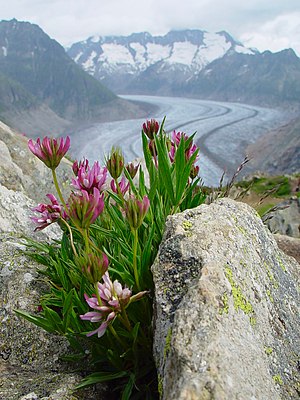Western Alps clover
| Western Alps clover | ||||||||||||
|---|---|---|---|---|---|---|---|---|---|---|---|---|

Western Alpine clover ( Trifolium alpinum ) on the Aletsch Glacier |
||||||||||||
| Systematics | ||||||||||||
|
||||||||||||
| Scientific name | ||||||||||||
| Trifolium alpinum | ||||||||||||
| L. |
The Trifolium alpinum ( Trifolium alpinum ) is a plant that to the subfamily of Schmetterlingsblütler (Faboideae) within the family of the Leguminosae part (Fabaceae or Leguminosae).
description
The Western Alpine clover is a bare, hibernating green, perennial, herbaceous plant that reaches heights of 5 to 20 centimeters. The tough taproot tastes sweet. All leaves are basal and divided into a petiole and a leaf blade. The petiole has a length of about 5 centimeters. The leaf blade is pinnate in three parts. The three leaflets are linear-lanceolate with a length of about 10 centimeters and can be described as having entire margins.
The flowering period extends from June to August. The cephalic inflorescence has a diameter of about 3 to 5 centimeters and contains three to twelve stalked, relatively large flowers. The hermaphrodite flowers, which have a balsamic scent when the sun is shining, are zygomorphic and five-fold with a double flower envelope . The bald and ten-veined calyx tube is longer than the flower stalks. The flesh-pink to purple-red petals are between 18 and 25 millimeters long and protrude eight times over the calyx tube.
The number of chromosomes is 2n = 16.
ecology
The western alpine clover is a hemicryptophyte . Its roots are over a meter deep.
Occurrence
The western alpine clover occurs particularly in the silicate chains of the central and southern Alps . It also occurs in the Pyrenees to the Apennines at altitudes between 1400 and 3100 meters. It prefers altitudes of over 1700 meters, but it also goes a little deeper locally. The eastern limit of its distribution roughly corresponds to an imaginary line from Arlberg to Lake Garda . To the west of this line it is absent almost everywhere in the Northern Limestone Alps and in larger areas in the Southern Limestone Alps; overall it occurs in Central Europe scattered.
The Western Alpine clover thrives best on lime-free, acidic, moderately nitrogenous soils that are not too shallow . It occurs in Central Europe in alpine climates . The western alpine clover colonizes mats rich in bristle grass and loose dwarf shrub stands. Its natural habitats include grass and crooked sedge lawns . He is a character species of the Nardion Association.
Others
The tap root decoction is used in folk medicine to treat chest problems .
The alpine clover is popular as feed for cows , sheep , chamois and marmots .
literature
- Xaver Finkenzeller, Jürke Grau : Alpine flowers. Recognize and determine (= Steinbach's natural guide). Mosaik, Munich 2002, ISBN 3-576-11482-3 . Xaver Finkenzeller, Jürke Grau: Alpine flowers. Recognize and determine (= Steinbach's natural guide ). Mosaik, Munich 2002, ISBN 3-576-11482-3 .
Individual evidence
- ↑ a b Western Alps clover. In: FloraWeb.de.
- ↑ a b c Erich Oberdorfer : Plant-sociological excursion flora for Germany and neighboring areas . 8th edition. Verlag Eugen Ulmer, Stuttgart 2001, ISBN 3-8001-3131-5 . Page 594.
- ↑ a b c d Dietmar Aichele, Heinz-Werner Schwegler: The flowering plants of Central Europe . 2nd Edition. tape 2 : Yew family to butterfly family . Franckh-Kosmos, Stuttgart 2000, ISBN 3-440-08048-X .
Web links
- Trifolium alpinum L. In: Info Flora , the national data and information center for Swiss flora . Retrieved November 17, 2015.
- Thomas Meyer: Data sheet with identification key and photos at Flora-de: Flora von Deutschland (old name of the website: Flowers in Swabia )

